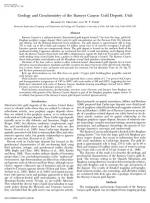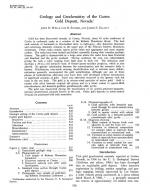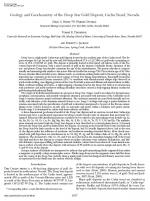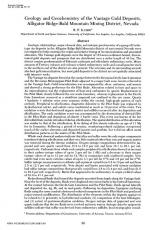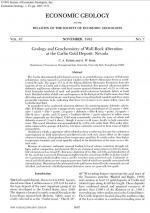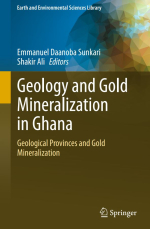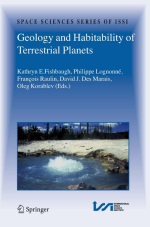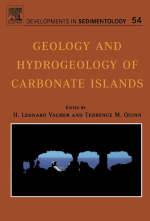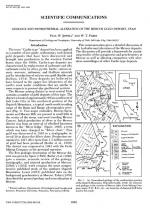The Carlin disseminated gold deposit occurs in an autochthonous sequence of Paleozoic sedimentary rocks exposed in a structural window in the Roberts Mountains thrust in north-central Nevada. The upper 175 m of the Silurian Roberts Mountains Formation hosts the majority of ore at Carlin and is characterized by laminated, fine-grained, calcareous and/or dolomitic argillaceous siltstone with local coarser grained siltstones and <0.25- to >50-cm-thick lenticular interbeds of sand- and granule-sized calcareous bioclastic debris or fossil hash. Detailed studies of drill core and exposures in the East pit of the Carlin mine show that alteration and mineralization are zoned away from crosscutting fault conduits and these more permeable bioclastic beds, indicating that these two features were major inflow zones for hydrothermal fluid.
In unoxidized rocks, unaltered calcareous siltstone (1) containing quartz, dolomite, calcite, illite, K feldspar, and pyrite is progressively converted to assemblages of (2) quartz + dolomite + calcite + illite + pyrite, (3) quartz + dolomite + illite-K mica + pyrite, (4) quartz + illite-K mica + pyrite, and (5) quartz + kaolinite-dickite + pyrite adjacent to inflow zones where jasperoids are developed. Gold most consistently enriches the zone of calcite and dolomite removal (3 and 4 above), though it occurs in all zones, locally in high concentrations. This zoned alteration was accomplished by a C02-rich acidic fluid. This acidic alteration enhanced the passage of fluids by extensive carbonate removal to form zones of higher permeability.
Oxidation is wholly a supergene effect related to deep weathering, because the oxidation is superimposed on both mineralized and altered rocks with only minor effect on the major element chemistry; it has produced low-temperature goethitic Fe oxides rather than higher temperature hematite and is not spatially related to Au distribution at the mine or on a district scale.
Because of extensive carbonate removal leading to local volume reduction through collapse and/or compaction, geochemical effects are examined using ratios to relatively immobile elements such as Al and Ti. Extensive depletion of Ca, Mg, and C02 and introduction of Si, Au, and S have occurred. Potassium is depleted in the conversion of illite to dickite-kaolin-ite in proximal silicified inflow zones, and Fe enriches some pyritized rock. Carbonate removal and silicification are two separate processes, both of which are spatially associated with mineralization. Mineralized decarbonated rocks and barren footwall rocks commonly are not silicified, and intensely silicified proximal alteration zones are generally low grade.



